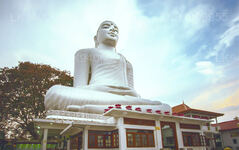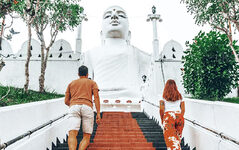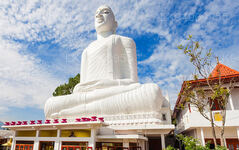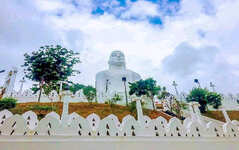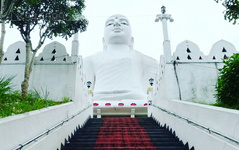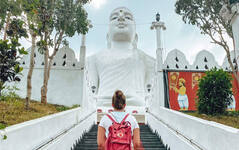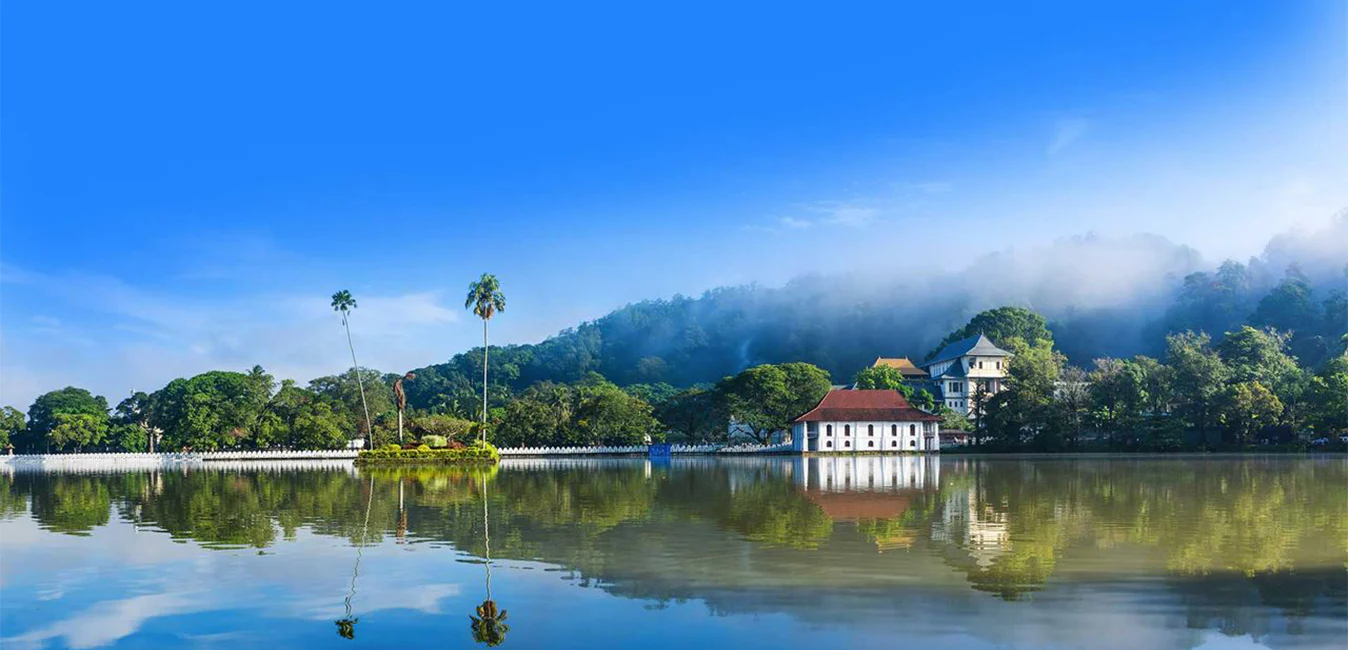
Kandy City
Kandy, a picturesque city in central Sri Lanka, is renowned for its rich cultural heritage, vibrant festivals, and scenic beauty. Nestled amidst lush hills, it is home to the Temple of the Tooth Relic, a UNESCO World Heritage Site, and offers a captivating blend of history and natural splendor.
Bahirawakanda Vihara Buddha Statue
Rising from a hill adjoining the holy city of Kandy is the giant Buddha statue of Bahirawa Kanda. The statue is a mere 2km from the Temple of The Tooth Relic and was built in 1972.
Folklore
Many legends surround the hill of Bahirawa Kanda which means ‘gnome mountain’; and about how this statue came to be. Chief amongst these are two stories.
The first speaks of an ancient temple to the primitive god of protection, Bahiravar; which was implanted there during the reign of the Nayakkar Kings. During the olden days in India, the standard methods of worship for this god often involved animal sacrifice; though human sacrifice was never involved. But for some reason this practice seems to have gotten twisted in the localisation process; and the priests of this temple threatened the wrath of the god unless hundreds of virgin women were sacrificed in time. The naive people of the region handed over a large number of girls for sacrifice and lived in fear of the god’s wrath. However, this came to an end when the fiance of the Chief of the Royal Mahouts was taken for sacrifice. The man, whose name was Dunuwilla Gajanayake Nilame, used his power in the palace and his bravery to get her released; and caused such a great disturbance that the sacrificing ritual was broken. This marked the end of the people’s fear and superstition; and the temple was abandoned with time.
Another story speaks of how the hill gained the name ‘Gnome Mountain’ or ‘Devil’s Hill’. According to this legend there was a time in the past when the mountain emitted strange noises and engulfed the people who lived nearby in abject fear. They believed that it was the work of an evil gnome and searched for a way to appease it. Meanwhile, unknown to anyone, an actual gnome had infilitrated the palace and taken the place of one of the ministers. Realising the opportunity; the ‘minister’ advised the king that the gnome would be appeased if a beautiful virgin was sacrificed every year, and hence a new superstition began. But then one year; the nominated sacrifice was the lover of the fake minister’s very own son. The villagers kidnapped her during the night, took her to the hill and left her there. The minister’s son discovered this in the morning and immediately set off to rescue her. He fought the gnome , his father, who had been there for his own nefarious purposes; and returned to the village. The alarmed and fearful people had begun to wonder if the rescue of the sacrifice had angered the gnome; when the cunning son quickly made a gnome sound (after all he was a gnome too, being the son of the original gnome). The people the took this to mean that the sacrifice was accepted; and the couple left the village that same night, instead of risk having their trick being discovered.
The Statue and the Sights
The Bahirawakanda Buddha Statue is located alongside the Sri Maha Bodhi Temple which is on the top of the Bahirawa Kanda hill. This beautifully sculpted white statue displays Buddha in the seated Nirvana pose and can be seen from the entire city of Kandy that sprawls out before it. It stands at 88 feet in height and is one of the biggest Buddha statues in Sri Lanka.
Visitors can climb the top of the hill for panoramic views of the City of Kandy, the inside of Bogambara Prison, and the mountain range nearby. It makes for some spectacular photographs and memories. The temple of Bahirawa Kanda is open for worship. Devotees are required to remove their hats and shoes; and can offer flowers or light oil lamps. There is also set of stairs that run behind the Buddha statue, that allow visitors to climb to a greater height for better views of the landscape. However, the best time to visit Bahirawakanda is at night, when the entire statue is lit up and the city of Kandy spreads out in a map of twinkling lights.
About Kandy District
Kandy district is situated in the centrel province of Sri Lanka. One of the seven World Heritage Sites in Sri Lanka, Kandy was once home to the Kandyan Kings of yore in the 16th-century and a fountainhead for all the music, arts, crafts and culture in the country. About 129 km away from Colombo, Kandy is ensconced amongst a hilly terrain and all eyes are drawn to the centre of the city, where the Kandy Lake forms a charming feature. Kandy retains great religious significance for Sri Lanka, because it is in this charming city that the Dalada Maligawa or "Temple of the Tooth" is located, within which the sacred tooth relic of Lord Buddha lies well guarded.
The Royal Botanical Garden, Peradeniya is situated about 5 km to the west of the city centre at Peradeniya and is visited by 1.2 million people per year. It is the largest botanical garden on the island. The Udawatta Kele (Udawatta Forest) is a protected sanctuary situated in the heart of the city, just north of Temple of the Tooth.
Kandy is a Sinhala majority city; there are sizeable communities belonging to other ethnic groups, such as Moors and Tamils. Kandy is second only to Colombo the center of the Sri Lankan Economy. Many major co operations have large branch officers in Kandy and many industries include textiles, furniture, Information Technology and jewellery are found here. Many agriculture research centers are located in the city.
And a fountainhead for all the music, arts, crafts and culture in the country. About 129 km away from Colombo, Kandy is ensconced amongst a hilly terrain and all eyes are drawn to the centre of the city, where the Kandy Lake forms a charming feature. Kandy retains great religious significance for Sri Lanka , because it is in this charming city that the Dalada Maligawa or Temple of the Toothis located, within which the sacred tooth relic of Lord Buddha lies well guarded.
About Central Provincce
The Central Province of Sri Lanka consists primarily of mountainous terrain. The province has an area of 5,674 km², and a population of 2,421,148. Some major towns include Kandy, Gampola (24,730), Nuwara Eliya and Bandarawela. The population is a mixture of Sinhalese, Tamil and the Moors.
Both the hill capital Kandy and the city of Nuwara Eliya are located within the Central Province as well as Sri Pada. The province produces much of the famous Ceylon tea, planted by the British in the 1860s after a devastating disease killed all the coffee plantations in the province. Central Province attracts many tourists, with hill station towns such as Kandy, Gampola, Hatton and Nuwara Eliya. Temple tooth or Dalada maligawa is the main sacred place in Centrel province.
The climate is cool, and many areas about 1500 meters often have chilly nights. The western slopes are very wet, some places having almost 7000 mm of rain per year. The eastern slopes are parts of the mid-dry zone as it is receiving rain only from North-Eastern monsoon. The Temperatures range from 24°C at Kandy to just 16°C in Nuwara Eliya, which is located 1,889 m above sea level. The highest mountains in Sri Lanka are located in the Central Province. The terrain is mostly mountainous, with deep valleys cutting into it. The two main mountain regions are the central massif and the Knuckles range to the east of Kandy.

